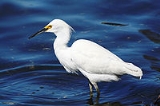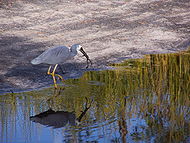
Egretta
Encyclopedia

Egretta is a genus of medium-sized heron
Heron
The herons are long-legged freshwater and coastal birds in the family Ardeidae. There are 64 recognised species in this family. Some are called "egrets" or "bitterns" instead of "heron"....
s, mostly breeding in warmer climates. Representatives of this family are found in most of the world, and the Little Egret
Little Egret
The Little Egret is a small white heron. It is the Old World counterpart to the very similar New World Snowy Egret.-Subspecies:Depending on authority, two or three subspecies of Little Egret are currently accepted....
, as well as being widespread throughout much of the Old World
Old World
The Old World consists of those parts of the world known to classical antiquity and the European Middle Ages. It is used in the context of, and contrast with, the "New World" ....
, has now started to colonise the Americas.
_in_ap_w_img_3625.jpg)
Egret
An egret is any of several herons, most of which are white or buff, and several of which develop fine plumes during the breeding season. Many egrets are members of the genera Egretta or Ardea which contain other species named as herons rather than egrets...
s in shape, long-necked and long-legged. There are few plumage features in common, although several have plumes in breeding plumage; a number of species are either white in all plumages, have a white morph (e.g. Reddish Egret
Reddish Egret
The Reddish Egret is a small heron. It is a resident breeder in Central America, The Bahamas, the Caribbean, the Gulf Coast of the United States, and Mexico. There is post-breeding dispersal to well north of the nesting range...
), or have a white juvenile plumage (Little Blue Heron
Little Blue Heron
The Little Blue Heron, Egretta caerulea, is a small heron. It breeds from the Gulf states of the USA through Central America and the Caribbean south to Peru and Uruguay. It is a resident breeder in most of its range, but some northern breeders migrate to the southeastern USA or beyond in winter...
).
The breeding habitat
Habitat (ecology)
A habitat is an ecological or environmental area that is inhabited by a particular species of animal, plant or other type of organism...
of Egretta herons is marshy wetlands in warm countries. They nest in colonies
Bird colony
A bird colony is a large congregation of individuals of one or more species of bird that nest or roost in close proximity at a particular location. Many kinds of birds are known to congregate in groups of varying size; a congregation of nesting birds is called a breeding colony...
, often with other wading birds, usually on platforms of sticks in trees or shrubs.
These herons feed on insect
Insect
Insects are a class of living creatures within the arthropods that have a chitinous exoskeleton, a three-part body , three pairs of jointed legs, compound eyes, and two antennae...
s, fish
Fish
Fish are a paraphyletic group of organisms that consist of all gill-bearing aquatic vertebrate animals that lack limbs with digits. Included in this definition are the living hagfish, lampreys, and cartilaginous and bony fish, as well as various extinct related groups...
and amphibian
Amphibian
Amphibians , are a class of vertebrate animals including animals such as toads, frogs, caecilians, and salamanders. They are characterized as non-amniote ectothermic tetrapods...
s, caught normally by cautious stalking.
Taxonomy
As with other heron groupings, the taxonomy of these birds has been a source of dispute. Some of these species have been placed with the great herons in ArdeaArdea (genus)
Ardea is a genus of herons. Linnaeus named this genus as the Great Herons, referring to the generally large size of these birds, typically 80–100 cm or more in length....
, and conversely the large white species like Great Egret
Great Egret
The Great Egret , also known as the Great White Egret or Common Egret, White Heron, or Great White Heron, is a large, widely-distributed egret. Distributed across most of the tropical and warmer temperate regions of the world, in southern Europe it is rather localized...
are occasionally allocated to Egretta.
The fact that some of the group are named as “heron” and some as “egret” has no taxonomic significance.
Species
- Little EgretLittle EgretThe Little Egret is a small white heron. It is the Old World counterpart to the very similar New World Snowy Egret.-Subspecies:Depending on authority, two or three subspecies of Little Egret are currently accepted....
, Egretta garzetta or Ardea garzetta - Snowy EgretSnowy EgretThe Snowy Egret is a small white heron. It is the American counterpart to the very similar Old World Little Egret, which has established a foothold in the Bahamas....
, Egretta thula - Reddish EgretReddish EgretThe Reddish Egret is a small heron. It is a resident breeder in Central America, The Bahamas, the Caribbean, the Gulf Coast of the United States, and Mexico. There is post-breeding dispersal to well north of the nesting range...
, Egretta rufescens - Slaty EgretSlaty EgretThe Slaty Egret, Egretta vinaceigula, is a small, dark egret. It breeds in Zambia, Botswana, Namibia and Mozambique. It is one of the species to which the Agreement on the Conservation of African-Eurasian Migratory Waterbirds applies...
, Egretta vinaceigula - Black HeronBlack HeronThe Black Heron also known as the Black Egret, is an African heron. It is a medium-sized , black-plumaged heron with yellow legs and feet. It is found south of the Sahara Desert, including Madagascar, and prefers shallow open waters, such as the edges of freshwater lakes and ponds...
, Egretta ardesiaca - Tricolored HeronTricolored HeronThe Tricolored Heron formerly known in North America as the Louisiana Heron, is a small heron. It is a resident breeder from the Gulf states of the USA and northern Mexico south through Central America and the Caribbean to central Brazil and Peru...
, Egretta tricolor also known as Louisiana Heron - White-faced HeronWhite-faced HeronThe White-faced Heron, Egretta novaehollandiae, also known as the White-fronted Heron, and incorrectly as the Grey Heron, or Blue Crane, is a common bird throughout most of Australasia, including New Guinea, the islands of Torres Strait, Indonesia, New Zealand, the islands of the Subantarctic, and...
, Egretta novaehollandiae or Ardea novaehollandiae - Little Blue HeronLittle Blue HeronThe Little Blue Heron, Egretta caerulea, is a small heron. It breeds from the Gulf states of the USA through Central America and the Caribbean south to Peru and Uruguay. It is a resident breeder in most of its range, but some northern breeders migrate to the southeastern USA or beyond in winter...
, Egretta caerulea - Pacific Reef Heron, Egretta sacra or Ardea sacra, also known as Pacific Reef Egret or Eastern Reef Heron
- Western Reef HeronWestern Reef HeronThe Western Reef Heron, Egretta gularis, also known as the Western Reef Egret, is a medium-sized heron. It occurs mainly on the coasts in tropical west Africa, the Red Sea, the Persian Gulf and east to India...
, Egretta gularis - Dimorphic EgretDimorphic EgretThe Dimorphic Egret is a species of heron in the Ardeidae family. It is found in Comoros, Kenya, Madagascar, Mayotte, Seychelles, and Tanzania.In 2009, the IUCN lumped Egretta dimorpha with the Little Egret Egretta garzetta....
, Egretta dimorpha - Chinese EgretChinese EgretThe Chinese Egret or Swinhoe's Egret, Egretta eulophotes, is a full-crested, white egret with yellow bill. It breeds in Russia, North Korea, South Korea and mainland China, and then migrates south through Japan, the Philippines, Malaysia, Singapore and Indonesia...
, Egretta eulophotes
A fossil
Fossil
Fossils are the preserved remains or traces of animals , plants, and other organisms from the remote past...
species, Egretta subfluvia, is known from the Late Miocene
Miocene
The Miocene is a geological epoch of the Neogene Period and extends from about . The Miocene was named by Sir Charles Lyell. Its name comes from the Greek words and and means "less recent" because it has 18% fewer modern sea invertebrates than the Pliocene. The Miocene follows the Oligocene...
or Early Pliocene
Pliocene
The Pliocene Epoch is the period in the geologic timescale that extends from 5.332 million to 2.588 million years before present. It is the second and youngest epoch of the Neogene Period in the Cenozoic Era. The Pliocene follows the Miocene Epoch and is followed by the Pleistocene Epoch...
of Florida
Florida
Florida is a state in the southeastern United States, located on the nation's Atlantic and Gulf coasts. It is bordered to the west by the Gulf of Mexico, to the north by Alabama and Georgia and to the east by the Atlantic Ocean. With a population of 18,801,310 as measured by the 2010 census, it...
.

